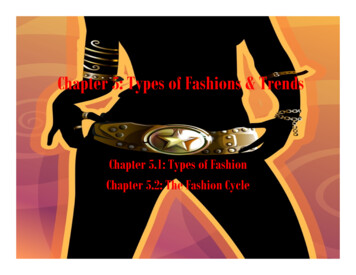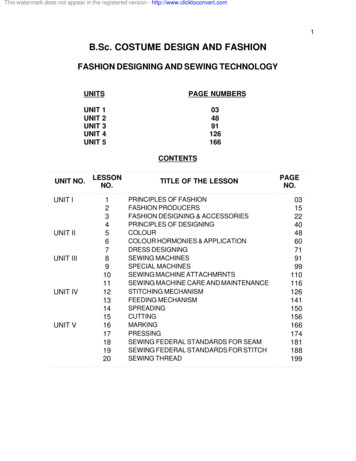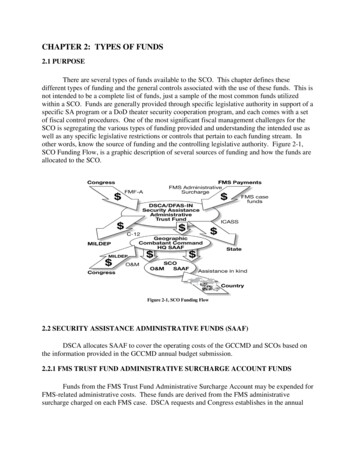
Transcription
Chapter 5: Types of Fashions & TrendsChapter 5.1: Types of FashionChapter 5.2: The Fashion Cycle
Key Terms LinesHardlinesSoftlinesApparelAccessoriesHome Furnishing
Types Of Fashion Products Manufacturers make a variety of product lines Lines are groups of styles and designs produced andsold as a set of related products for a given season Hardlines are lines of products that are non-textile,such as appliances and home accessories Softlines are lines of products made from textiles thatinclude apparel and household items such as towelsand linens Manufacturers specialize in producing categories offashion products for certain groups
Types of Apparel Apparel is the term used for clothing, as in personal attire orgarments Apparel is categorized as: Women’s Wear Men’s Wear Infant’s and Children’s Wear Within these groups, there are other divisions based on: Brands Age Groups Sizes Prices Styles Offered
Product Numbers Apparel producers designate a certainnumber to represent each style ofapparel so manufacturing and orderfulfillment of the product is moreefficient Retailers use the same style numberswhen ordering: then divide thosenumbers into categories, such as colors,sizes, and classifications This helps maintain accurate inventory
Types of Accessories Accessories are fashion items that areadded to complete or enhance outfits They include: Footwear Handbags Headwear Scarves Neckties Jewelry Gloves Hosiery Most accessories are softlines, but allare categorized with soft goods
Varied Use of Accessories Accessories can be usedto: Create a new look Update a basic garment Transform a garmentstyle from casual toformal
Special Accessory Procedures Manufacturers specialize inproducing each type ofaccessory Designers and producersmust stay on top of trends inaccessory fashion andapparel fashion Top designers now producetheir own accessories
Home Furnishing Home furnishings is the fashion productcategory that includes textiles used tofurnish and decorate the home, such astowels, linens, and bedding
Categories of Home Furnishing Designers in the home furnishing industry createfashion through the use of colors, designs, and fabrics Consumers want the fabrics to be strong, durable,colorfast and stain resistant Three categories of home furnishing: Domestics (bed linens, bathroom items, table & kitchenlinens) Home Furnishings (window treatments, upholsteryfurniture, throw pillows) Floor Coverings (carpeting, area rugs, throw rugs, nonfabric floor tiles)
Home Furnishings & TheEconomy In times of hardship,people spend less moneyon home furnishings With high levels ofemployment, peoplespend extra money New home sales directlyaffect the purchase ofhome accessories
Categories & Classificationsin Apparel The maincategories ofapparel are: Women’s wear Men’s wear Infant’s wear Children’s Wear
Women’s Wear The women’s wear category represents thelargest share of the apparel industry The industry manufacturers new lines for fivedifferent seasons each year The retail life of a line is approximately 10weeks
Women’s Wear The women’s wear classifications are: Sportswear separates(tops, bottoms) Dresses (casual to dressy) Evening and Bridal(cocktail dresses, weddinggowns, formal attire) Maternity Outwear (coats, rainwear) Suits (indoor jackets w/pants or skirts) Active wear (dancewear,jogging suits) Swimwear/ beachwear Intimate Apparel Accessories Footwear Miscellaneous apparel(uniforms, aprons)
Women’s Wear Sizes include: Misses- regular sizes 2 to 14 Women’s- plus sizes for larger women Petite- designed for women under 5 feet 4 inchestall Juniors- younger figures with odd sizes 1 to 13
Men’s Wear Fashion marketers present 2 lines a year Fall/ Winter Spring/ Summer Different seasons determine fabric weight Men wear suits year round Men’s sportswear market has become styleconscious, resulting in apparel makersshowing new sportswear lines 4 times a year
Men’s Wear Men’s wear producers specialize in categories The classifications include: Tailored apparel (suits, overcoats, sports coats, dresstrousers) Furnishings (dress shirts, neckwear, underwear, hats,socks) Heavy Outerwear (parkas, ski pants, jackets) Work Clothing Footwear Miscellaneous Apparel (rainwear, uniforms, caps)
Men’s Wear
Infants’ & Children’s Wear Back to school is a big event for the children’s wearindustry Pre-fall is 1 of 3 main production seasons formanufacturers Fashion producers present new styles, fabrics, andcolors The other 2 seasons are Spring/ Summer and WinterHoliday
Trends in Infants’ andChildren’s Wear Designers are migrating to children’s fashions Licensing of children’s fashions has become a big business For decades Disney and Sesame Street characters haveappeared on children’s apparel for all age groups Safety trends has affected the industry. (flame-retardantfabrics must be used)
Classifying Infants’ &Children’s Wear Children’s clothing are organized by gender Boys Girls Sizes reflect age groups Infant Toddler Young Children’s (sizes 2-6x) Girls ( sizes 6-14) Boys (sizes 6-20)
Variety of Fashion Fashion encompasses a broad range ofproducts that include not only apparel forthe whole family, but also textile productionthat include home items Categories and classifications of theseproducts allow producers and retailers tomake, market, and sell fashion to consumers
Chapter 5: Types of Fashions & TrendsChapter 5.2: The Fashion Cycle
Key Terms Fashion CycleFashion MovementFashion LeadersTrickle-Down TheoryTrickle-Up TheoryTrickle-Across TheoryFashion TrendFad
Changing Fashions The only constant in the fashion world isthat consumers look for new fashions anddesire change. The ongoing motion of fashions movingthrough the fashion cycle
The Fashion Cycle The fashion cycle is the period of time or lifespan during which the fashion exists, movingthrough five stages: Introduction, Rise Peak Decline Obsolescence Fashion moves through different stagesduring its cycle of existence The cycle represents levels of acceptance
Stages of the Fashion Cycle
Introduction Stage Designs are 1st previewedUpward slope on curveLimited number of people accept itOffered at high prices, and in smallquantities
Rise Stage 1st incline up the hill This is when manufacturers will copy the designs, andproduce them for less Less expensive fabrics Minimizing details Mass production reduces the price of the fashion
Peak Stage This stage is at the top of the hillThe fashion is at its most popular and accepted stagePrices will vary because so many have copied the fashionThe fashion can possibly become a classicSimple changes to maintain popularity include: Details of Design Color Texture
Decline Stage This stage is a downward slope of the curve Consumers have grown tired of the fashion, anddesire something new The market can be oversaturated Fashion retailers begin to mark down the price ofthe merchandise Makes room for new designs
Obsolescence Stage The end of the fashion cycle, at the bottomof the hill Consumers are no longer interested Prices are low Consumers may not buy the product
Fashion-Cycle Life Span All fashions follow the life-cycle pattern The rate of movement varies It all depends on the willingness of theconsumer’s to accept the fashionOrganicFabrics
Fashion Movement A fashion movement is the ongoing motionof fashion moving through the fashion cycle Factors that affect the fashion movementinclude: Economic Social Factors Introduction of newfibers and fabrics Advertising techniques
Old Is New Again History repeats itself Keep everything, it will come back into style
Leading The Fashion Way Fashion leaders are the trendsetters, orindividuals who are the first to wear newstyles, after which the fashion is adopted bythe general public Who are the trendsetters: Royalty Wealthy Celebrities
Theories of FashionMovement Fashion Trend is the direction of movementof fashion that is accepted in themarketplace Trickle-Down Theory Trickle-Up Theory Trickle-Across Theory
Trickle-Down Theory A hypothesis that states the movement offashion starts at the top with consumers ofhigher socioeconomic standards and movesdown to the general public Example: Jackie Kennedy
Trickle-Up Theory A hypothesis that states the movement of fashionstarts with consumers on lower-income levels andthen moves to consumers with higher incomes Examples Include Athletic Apparel 1970’s and 1980’s Hair Styles Punk style Grunge style
Trickle-Across Theory A hypothesis stating that fashion acceptancebegins among several socioeconomic classesat the same time
Fashion Trends vs. Fads A fad is a fashion that is popular for a shortperiod of time A fad can be recognized by its sudden appearanceand disappearance A trend can be a fad that has withstood the test oftimeTrendFad
Changing Fashions Each new season challenges fashionproducers, designers, and marketers todevelop new approaches and ideas to meetconsumer demand
Chapter 5: Types of Fashions & TrendsTHE END
Types Of Fashion Products Manufacturers make a variety of product lines Lines are groups of styles and designs produced and sold as a set of related products for a given season Hardlines are lines of products that are non-textile, such as appliances and home accessories Softlines are lines of products made from textile










